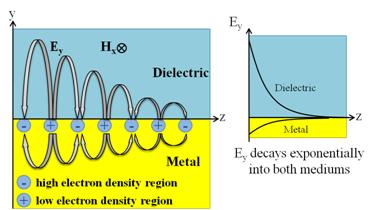Current CMOS technology objection is to provide sufficient bandwidth and data rate at different levels of ON- and OFF-chip interconnection. Existing metallic interconnects are not capable of providing required bandwidth with minimum signal delay, cross-talk, and power dissipation. Integration of optics with electronics is proposed as a solution in order to meet the desired properties. Nevertheless, the challenge is to overcome the size mismatch between these two technologies, since optical components’ size is limited to the law of diffraction (optical components cannot be smaller than several fractions of propagation wavelength), while electronics is already operating at nanoscale dimension. Plasmonics technology is a favourable approach to address this problem as well.

Surface plasmon polaritons (SPPs) are defined as electromagnetic waves that propagate along an interface of two media with dielectric constants of opposite signs. Consequently, SPPs exist at dielectric-metal interface at optical frequencies (since ɛmetals < 0 and ɛdielectrics > 0 at optical frequencies), and decay exponentially into both media. For a structure comprised of a thin metallic layer of finite width, embedded in a homogenous dielectric, corner modes and finite length edge modes of metal couple to each other and form two symmetric and asymmetric modes. The so-called long-range surface plasmon (LR-SPP) is a symmetric mode, and its low attenuation constant leads to an increase in its propagation length. Additionally, since this structure is composed of metallic layer it has the potential to carry electrical signal as well as optical signal.

At Photonic DataCom team, we are working on simulation, fabrication, and characterization of LR-SPPs waveguides, hoping to realize optimal optical and electrical data transmission through surface plasmon waveguides.
Winter 2022
- Prof. Liboiron-Ladouceur will be teaching ECSE-596 Optical Waveguides.
Fall 2021
- We welcome Rebecca Rogers (MSc) and Hasan Hoji (MSc) who joined the research group.
